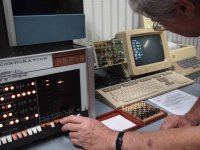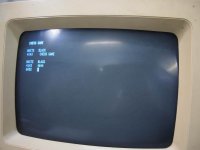1944GPW
Veteran Member
A few months ago I managed to get to see what is claimed as Australia's oldest running computer, a PDP-8 Straight 8. The machine was used by the Australian Department of Defence in Adelaide from 1967. After a long and detailed recent restoration it is now complete and runs FOCAL and chess, shown here. Needless to say it is a real beauty! The current loop interface had to be adjusted down I believe from 60mA to 20mA to work with the VT220. Apart from the VT220 it has a PC05 portable reader and a ASR33 teletype attached. The owner would like some ideas on an easy way to transfer code from a laptop to this machine - presumably a USB to 20mA interface, if such a thing exists?




Steve.




Steve.
